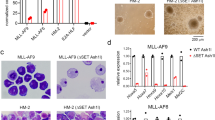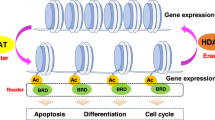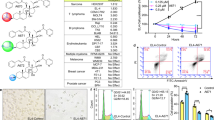Abstract
The novel immunosuppressant AS1387392 has been isolated from Acremonium sp. No. 27082. This compound showed a strong inhibitory effect against mammalian histone deacetylase and T-cell proliferation. Further, AS1387392 showed a good oral absorption, and its plasma concentration was higher than that of FR235222, an analog of AS1387392 that inhibited histone deacetylase previously reported. Given these findings, AS1387392 may represent an important new lead in developing immunosuppressant.
Similar content being viewed by others
Introduction
In recent years, cyclosporin A and FK506, two calcineurin inhibitors from microorganisms, have been developed for clinical use in organ transplants.1 However, while these compounds have proven effective in the treatment of various autoimmune diseases, their clinical application is limited by their side effects.2, 3, 4, 5 To overcome this problem, a safer, more effective novel immunosuppressive agent is needed.
In 2003, Mori et al.6, 7 isolated the compound FR235222 (Figure 1) from the fungus Acremonium sp. No. 27082. FR235222 showed potent inhibitory effects on the activity of mammalian histone deacetylase (HDAC) and marked immunosuppressive effects both in vitro and in vivo.8 However, this compound did not have a good enough pharmacokinetic profile. In an investigation for novel analogs of FR235222 with improved profiles, Acremonium sp. No. 27082 was found to produce the novel immunosuppressant AS1387392 (Figure 1).
Here, we describe the fermentation, isolation, physicochemical properties and biological activities of AS1387392.
Materials and methods
Producing strain
The fungal strain Acremonium sp. No. 27082 was originally isolated from a soil sample, collected in Akita-city, Akita-prefecture, Japan, previously reported.6
Media used for seed culture and production
The seed medium consisted of sucrose 4%, glucose 2%, soluble starch 2%, pharmamedia 3% (Archer Daniels Midland, Decatur, IL, USA), soybean flour 1.5%, KH2PO4 1%, CaCO3 0.2%, Adekanol 0.1% (defoaming agent; Asahi Denka, Tokyo, Japan), and silicone 0.1% (defoaming agent, Shin-Etsu Chemical, Tokyo, Japan). The production medium consisted of Pindex #3 6% (Matsutani Chemical Industry, Hyogo, Japan), glycerol 0.5%, pharmamedia 6%, L-isoleucine 0.5%, L-proline 0.3%, KNO3 1%, CoCl2 0.005%, MnSO4 0.005%, Adekanol 0.1% (Asahi Denka) and silicone 0.1% (Shin-Etsu Chemical).
Fermentation
Aqueous seed medium (100 ml) was poured into a 500-ml Erlenmeyer flask and sterilized at 121 °C for 30 min. The seed flasks were inoculated with a loopful of the slant culture of Acremonium sp. No. 27082, and then shaken on a rotary shaker at 250 r.p.m. at 25 °C for 5 days. After this incubation, 10 ml of the seed culture was transferred to seven 500-ml Erlenmeyer flasks containing 100 ml of the same medium. The flasks were shaken on a rotary shaker at 220 r.p.m. at 25 °C for 2 days, and 700 ml of the second seed culture was inoculated into a 200-l jar fermentor containing 140 l of the production medium. Fermentation was subsequently carried out at 26 °C for 10 days under aeration at 200 l min–1.
HPLC analysis
AS1387392 in the fermentation broth was detected by HPLC (L-4000 UV detector, L-6000 pump and L-7300 column oven; Hitachi High-Technologies, Tokyo, Japan) using an ODS column (ODS-BP, 150 mm × 4.6 mm ID; Daiso, Osaka, Japan). The mobile phase was 45% aqueous acetonitrile, and the flow rate was 1.0 ml min–1. The detection wavelength was set at 210 nm, and the column was heated at 50 °C.
Another HPLC analysis was performed using the conditions described above except for the mobile phase, which was 35% aqueous tetrahydrofuran (THF) in repeated ODS chromatography.
Assay for HDACs and splenocyte proliferation
In this study, the assay for HDACs and splenocyte proliferation was conducted in accordance with the method previously proposed by Mori et al.6 Human HDACs used in this experiment represent a mixture of several isozymes. HDACs and [3H]-acetyl histones were prepared from human T-cell leukemia Jurkat cells. Splenocytes harvested from female BALB/c mice (Charles River Japan, Kanagawa, Japan) were cultured with AS1387392 or FR235222 in medium containing 1 μg ml–1 anti-CD3 antibody at 37 °C for 3 days. After being cultured, proliferation was measured using alamar blue (Promega, Fitchburg, WI, USA).
Measurement of plasma concentration in rats after oral administration
Compounds were orally administered in triplicate to 8-week-old male Lewis rats (Charles River Japan) at a dose of 3.2 mg kg–1 dissolved in 10% NIKKOL HCO-60 solution (Nikko Chemicals, Tokyo, Japan). After administration, blood samples were periodically taken, and then centrifuged (10 000 g, 10 min, 4 °C) to obtain plasma samples. The plasma samples were then diluted by half with water and extracted with four volumes of ethyl acetate. Compound concentration was monitored by LC-MS/MS using an Agilent HP1100 (Hewlett-Packard, Palo Alto, CA, USA). The column was Inertsil ODS-3 (2.1 mm × 150 mm ID.; GL Sciences, Tokyo, Japan) and the mobile phase was 70% aqueous acetonitrile containing 10 mM ammonium acetate. The flow rate was 0.2 ml min–1, and the column was heated at 50 °C. Detection was done by, selected reaction monitoring in positive ion mode using API2000 (Applied Biosystems, Foster City, CA, USA).
Results
Fermentation and isolation
Fermentation was carried out as described above. After 10 days of cultivation, AS1387392 was isolated according to the scheme shown in Figure 2. The culture broth (150 l) was extracted by stirring with 150 l of methanol. The methanol extract was filtered using diatomaceous earth, and the filtrate was passed through a 35-l Diaion HP-20 column (Mitsubishi Chemical, Tokyo, Japan). The column was washed with 50% aqueous methanol and eluted with 40 and 50% aqueous acetonitrile. The elution was monitored by HPLC analysis. After dilution with 120-l of water, the elution (120 l) was applied to a 19-l Daiso ODS-B column (Daiso) packed with water. The column was then washed with 30% aqueous acetonitrile and further eluted with 40% aqueous acetonitrile. The active fraction was diluted with an equal volume of water and applied to a 19-l Daiso ODS-B column (Daiso) packed with 20% aqueous acetonitrile. The column was then eluted with 35% aqueous THF.
The elution was then rechromatographed as above mentioned at least three times. The end point was determined by HPLC analysis using THF as the mobile phase. Repeated ODS chromatography using 35% aqueous THF produced AS1387392 with high purity. The active fraction was diluted with an equal volume of water and applied to a 19-l Daiso ODS-B column (Daiso) packed with water. The column was then eluted with 60% aqueous methanol, after which the fraction containing the AS1387392 was diluted with an equal volume of water and subsequently applied to a 2-l Daiso ODS-B column (Daiso) column packed with water.
The column was finally eluted with 40% aqueous acetonitrile, and the active fraction was concentrated in vacuo and extracted with ethyl acetate. The solvent extract was concentrated under reduced pressure and dissolved in 250 ml of tert-butyl alcohol. Lyophilization produced 79.4 g of AS1387392 as a white powder.
Physicochemical properties
The physicochemical properties of AS1387392 are described in Table 1. AS1387392 was soluble in methanol, ethyl acetate, chloroform and dimethyl sulfoxide, and was slightly soluble in water. Positive color reactions were observed with iodine vapor, Ce(SO4)2-H2SO4 and Drangendorff reagent, where results from Molish’s, Ehrlich’s, FeCl3 and ninhydrin reactions were negative. The observed specific rotation was –85° (c 0.2, methanol), and the exact molecular mass (as determined by ESI–TOF–MS) was 543.3184 Da ([M+H]+), corresponding to the molecular formula C29H42N4O6 (theoretical [M+H]+=543.3182 Da). The amino-acid composition of AS1387392, as determined by Marfey’s method, was L-phenylalanine, L-isovaline and D-proline.9
Structure elucidation
The molecular formula of AS1387392 was a CH2 less than FR235222. The 1H NMR spectrum of AS1387392 (see Figure 3) was quite similar to that of FR235222 except for the absence of the doublet methyl signal (0.88 p.p.m.) due to 4-methylproline (MePro). In the 13C NMR spectrum of AS1387392, a new methylene signal (25.0 p.p.m.) appeared at the expense of methyl (18.1 p.p.m.) and methine (32.8 p.p.m.) of FR235222. Apart from the proline part, the 13C NMR data of AS1387392 closely matched the relevant 13C data of FR235222 (see Table 2). This information indicated that the MePro residue of FR235222 was replaced by proline in AS1387392. Finally, the structure was determined to be cyclo[(2S,9R)-2-amino-9-hydroxy-8-oxodecanoyl-L-isovalyl-L-phenylalanyl-D-prolyl] by a successful total synthesis of AS1387392. A full account of the total synthesis will be reported in a separate paper. The complete 1H and 13C assignments were made by COSY, HSQC, HMBC and are summarized in Table 2 along with the 13C data of FR235222.
Biological activity
AS1387392 exerted an inhibitory effect on the activity of human partially purified HDACs, with an IC50 value of 22 nM (Table 3). Further, this compound exerted potent inhibitory activity against splenocyte proliferation, with an IC50 value of 4.6 nM. These results indicate that the inhibitory effects of AS1387392 are as potent as those of FR235222.
Plasma concentration of AS1387392 in rats
The Cmax of AS1387392 after oral administration (3.2 mg kg–1) was 0.041 μg ml–1, and the area under the curve from 0 to 6 h after administration (AUC0−6 h) was 0.039 μg h ml–1 (Table 4). These values were approximately two to three times higher than those of FR235222, suggesting that AS1387392 might be more potent than FR235222 in an animal model.
Discussion
In this study, we effectively isolated the novel fungal product AS1387392 as a potent immunosuppressant from culture broth of Acremonium sp. No. 27082 in an examination for novel analogs of FR235222 with improved profiles. The results of our analysis showed that AS1387392 was a novel, powerful HDAC inhibitor with a good oral absorption profile. These characteristics suggest that the compound may be a good candidate as a new immunosuppressive agent. Further studies on AS1387392-derived compounds may provide a still more effective and safer immunosuppressant.
Purification of AS1387392 was hampered by the difficulties encountered in separating out impurities. Given that these impurities had the same UV and MS spectrum as AS1387392, we considered that the impurity may be an analog of AS1387392. On changing the mobile phase in separations, however, we found that repeated ODS chromatography using THF as the mobile phase eliminated the impurity. As a result of this purification, the impurity was not detected in HPLC analysis using both acetonitrile and THF as the mobile phase (Supplementary information).
Structure elucidation of AS1387392 has shown it to have a novel structure, in which the MePro residue of FR235222 is changed to proline (Figure 1). Inhibition studies showed that AS1387392 possesses HDAC inhibitory effects as potent as those of FR235222, while maintaining a higher plasma concentration in rats than FR235222. These findings suggest that AS1387392 may be more effective than FR235222 in treating delayed-type hypersensitivity, adjuvant-induced arthritis and heterotopic heart transplant.
In summary, we showed that AS1387392 was a novel and powerful HDAC inhibitor with an excellent oral absorption profile. This compound may be a good candidate as a new immunosuppressive agent. Subsequent studies on AS1387392-derived compounds may provide a still more effective and safer immunosuppressant.
References
First, M. R. Immunosuppressive agents and their actions. Transplant. Proc. 34, 1369–1371 (2002).
Gorantla, V. S. et al. Immunosuppressive agents in transplantation: mechanism of action and current anti-rejection strategies. Microsurgery 20, 420–429 (2000).
Su, Q. L., Weber, M., Hir, M. L., Zenke, G. & Ryffel, B. Nephrotoxicity of cyclosporin A and FK506: inhibition of calcineurin phosphatase. Ren. Physiol. Biochem. 18, 128–139 (1995).
Mcdiarmid, S. V., Colonna, J. O., Shaked, M., Ament, M. E. & Busuttil, R. W. A comparison of renal function in cyclosporine- and FK506-treated patients after primary orthotopic liver transplantation. Transplantation 56, 847–853 (1993).
Bechstein, W. O. Neurotoxicity of calcineurin inhibitors: impact and clinical management. Transpl. Int. 13, 313–326 (2000).
Mori, H. et al. FR235222, a fungal metabolite, is a novel immunosuppressant that inhibits mammalian histone deacetylase (HDAC). I. Taxonomy, fermentation, isolation and biological activities. J. Antibiot. 56, 72–79 (2003).
Mori, H. et al. FR235222, a fungal metabolite, is a novel immunosuppressant that inhibits mammalian histone deacetylase (HDAC). III. Structure determination. J. Antibiot. 56, 181–185 (2003).
Mori, H. et al. FR235222, a fungal metabolite, is a novel immunosuppressant that inhibits mammalian histone deacetylase (HDAC). II. Biological activities in animal models. J. Antibiot. 56, 80–86 (2003).
Fujii, K., Ikai, Y., Oka, M., Suzuki, M. & Harada, K. I. A non-empirical method using LC/MS for determination of the absolute configuration of constituent amino acids in a peptide: combination of Marfey’s method with mass spectrometry and its practical application. Anal. Chem. 69, 5146–5151 (1997).
Acknowledgements
We thank Ms Michiko Iitsuka for conducting the ESI-TOF-MS measurement of AS1387392.
Author information
Authors and Affiliations
Corresponding author
Additional information
Supplementary Information accompanies the paper on The Journal of Antibiotics website
Supplementary information
Rights and permissions
About this article
Cite this article
Sasamura, S., Sakamoto, K., Takagaki, S. et al. AS1387392, a novel immunosuppressive cyclic tetrapeptide compound with inhibitory activity against mammalian histone deacetylase. J Antibiot 63, 633–636 (2010). https://doi.org/10.1038/ja.2010.51
Received:
Revised:
Accepted:
Published:
Issue Date:
DOI: https://doi.org/10.1038/ja.2010.51
Keywords
This article is cited by
-
Progress in discovery and development of natural inhibitors of histone deacetylases (HDACs) as anti-cancer agents
Naunyn-Schmiedeberg's Archives of Pharmacology (2024)
-
Peptides as epigenetic modulators: therapeutic implications
Clinical Epigenetics (2019)
-
Medicinal significance of naturally occurring cyclotetrapeptides
Journal of Natural Medicines (2016)
-
Bioconversion of AS1387392: screening and characterization of actinomycetes that convert AS1387392 to AS1429716
The Journal of Antibiotics (2010)
-
Bioconversion of AS1387392: bioconversion studies involving Amycolatopsis azurea JCM 3275
The Journal of Antibiotics (2010)






